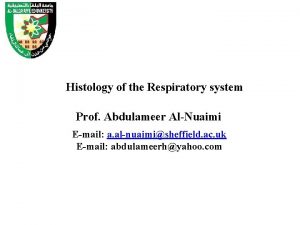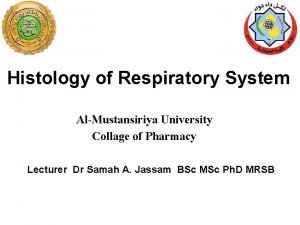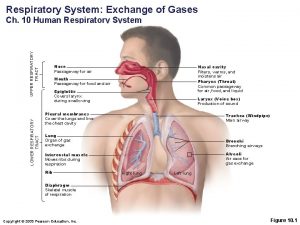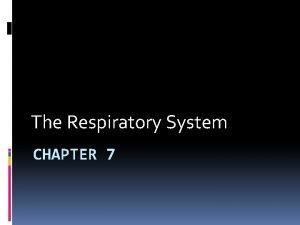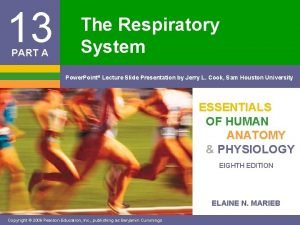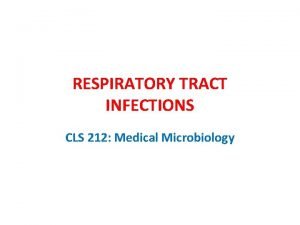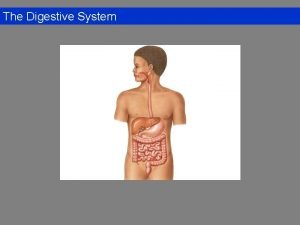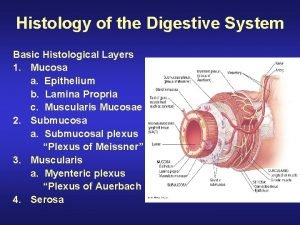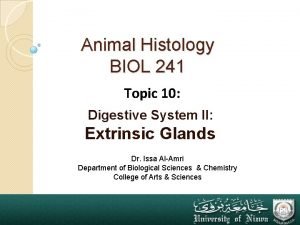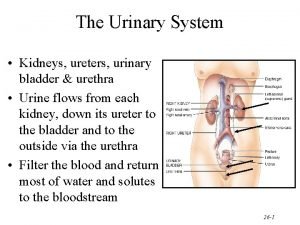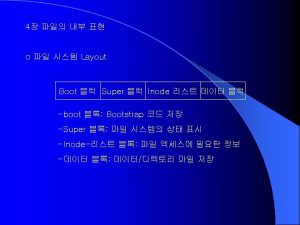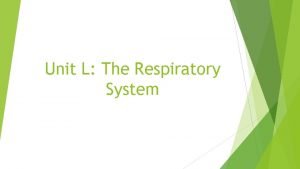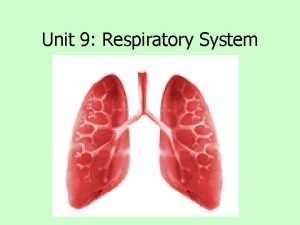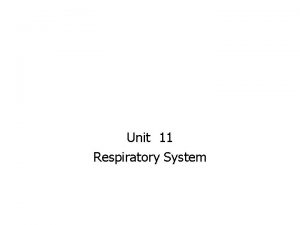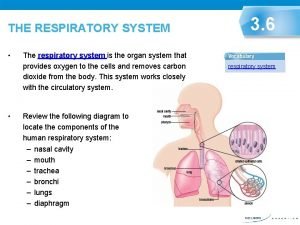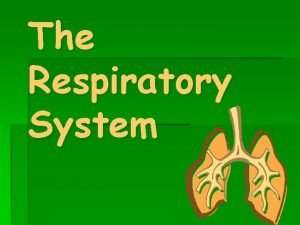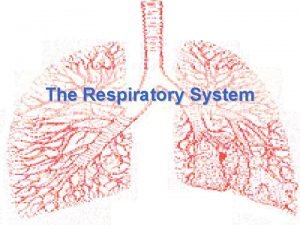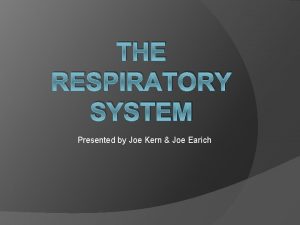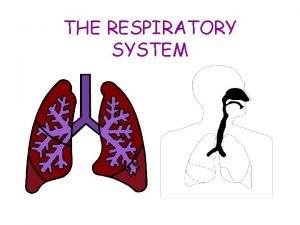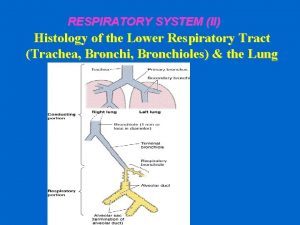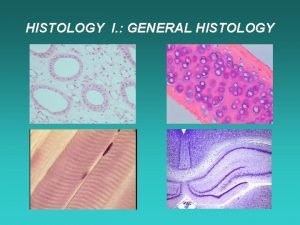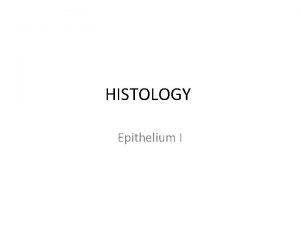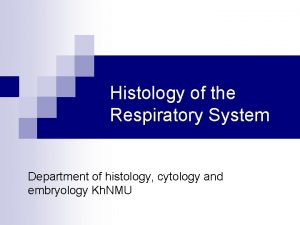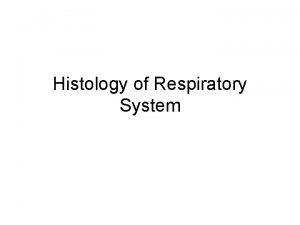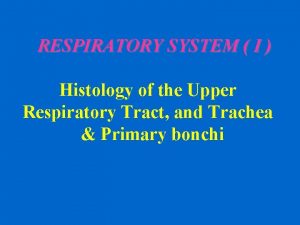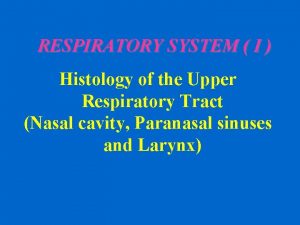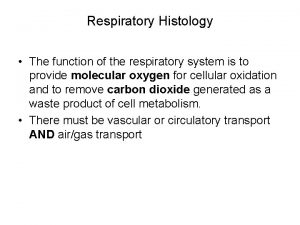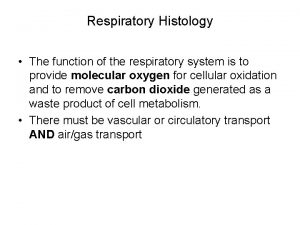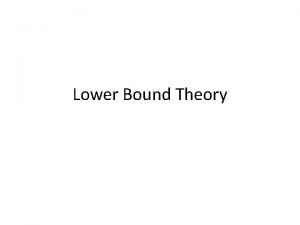HISTOLOGY OF LOWER PART OF RESPIRATORY SYSTEM RESPIRATORY











































- Slides: 43

HISTOLOGY OF LOWER PART OF RESPIRATORY SYSTEM



RESPIRATORY EPITHELIUM Most of the conducting portion is lined by pseudostratified ciliated columnar epithelium with rich population of goblet cells called respiratory epithelium.

Bronchial tree

INTRAPULMONARY PART OF CONDUCTING SYSTEM Primary bronchus divides into , Secondary bronchus or lobar bronchus. Tertiary bronchus/ segmental bronchus Bronchioles Terminal bronchiole: last portion of conducting system


FUNCTIONAL COMPONENTS OF RESPIRATORY SYSTEM • CONDUCTING PORTION or cleaning system • RESPIRATORY PORTION or gaseous interchange system


TRACHEA

TRACHEA 1. Mucosa 2. Submucosa 3. Cartilaginous/smooth muscle layer 4. Adventitia

TRACHEA

TRACHEA

Mucosa • Common types of cells: - Pseudo-stratified ciliated columnar - Goblet cells - Basal cells (stem cells)

• Less common types of cells are – - Brush cells ( seen in association with nerve fibres, sensory function) - Argentaffin cells ( small granule cells): reflex regulating function

Lamina propria • Situated underneath the epithelium • Made up of loose connective tissue rich in elastic fibres

Submucosa • Contains seromucous glands (tracheal glands) - Serous secretion – keeps lumen moist - Mucous secretion- traps the small dust particles

Cartilaginous/smooth muscle layer • Hyaline cartilage with perichondrium forms anterior two thirds of tracheal circumference. • Posterior one third is completed by smooth muscles with fibroelastic tissue(trachealis muscle).

Adventitia • Connective tissue (elastic and collagen fibres), blood vessels

Lung • 2 parts – - Conducting part ( intrapulmonary bronchi, bronchioles and different orders of braching) - Respiratoty part ( alveolar ducts, alveolar sacs and alveoli)



LOBAR BRONCHUS OR SECONDARY BRONCHUS

BRONCHIOLE

Bronchus Bronchiole Lined by pseudostratified Lined by columnar epithelium ciliated epithelium Islands of hyaline cartilage are Cartilage is absent present More than 1 mm in diameter Less than 1 mm in diameter Seromucus glands are present Glands are absent Goblet cells are present Goblet cells are absent

RESPIRATORY EPITHELIUM Most of the conducting portion is lined by pseudostratified ciliated columnar epithelium with rich population of goblet cells called respiratory epithelium. Typical respiratory epithelium consists 8 types of cells that lines the tracheo-bronchial passages. They are, 1. Ciliated columnar cells. 2. Goblet cells.

3 Serous cells 4 Clara cells 5 Basal cells 6 Intermediate epitheliocytes 7 Brush cells 8 Kulchitsky (P cells or neuroendocrine or Argentaffin cells)

Different types of cells present in the intrapulmonary bronchial tree

CILIATED COLUMNAR CELL • Tall or low columnar cells • Beating of the cilia moves mucous forward • Each cell has 300 cilia

GOBLET CELL • These produce mucous which trap dust particles. • Present throughout except bronchiole.

SEROUS CELL • Apical – mucin vacuoles • Secretes Ig A antibody

• CLARA CELL Only in respiratory bronchiole • Similar to type II alveolar cell • Cuboidal non ciliated cells, has blunt projections • It contain electron dense secretory granules and many lysosomes. • Important source of surfactant

BRUSH CELL • These are sensory in function • Slender cells with microvilli. • They are in contact with afferent nerve fibers and so are consider as sensory receptor in function.

SMALL GRANULE Kulchitsky / CELL • Function neuroendocrine cell – Regulates bronchial secretion – Smooth muscle contraction – Ciliary action – Secrete serotonin, may stimulate the bronchial muscle. • Rounded shape, dense cored vesicles.

INTERMEDIATE CELL • These immature forms of other cells

BASAL CELL • These are stem cells. • These cells are mitotic stem cells for other type of epithelial cells. • Small rounded cells are in contact with basal lamina.

Respiratory part • Alveolar ducts • Alveolar sacs • Alveoli

Alveolar epithelial cells (pneumocytes) • Type I alveolar cells: - simple squamous cells (flat cells with scanty cytoplasm)

• Type II alveolar cells: - Rounded cells , protrudes from alveolar surface - Free surface bears microvilli - Produces surfactant

• Alveolar macrophages (Dust cells/ Heart failure cells): - Phagocytose the dust particles - Presence of these cells in sputum is of diagnostic importance. - If found with RBC’s , it is indicative of CCF.

Surfactant - complex mixture of lipid and protein - Forms a thin film over the alveolar surface - Derived from Clara cells and type II pneumocytes - Reduces the surface tension and makes the ventilation of alveoli much more efficient.

Identification points • TRACHEA 1. Lumen is lined by pseudostratified ciliated columnar epithelium with goblet cells. 2. Submucous layer has seromucous glands. 3. Anterior 2/3 rd has cartilagenous layer which has hayline cartilage with perichondrium. 4. Posterior 1/3 rdpart has smooth muscle which is called as trachealis.

Identification points • LUNGS 1. Conducting part has cut section of bronchus and bronchiloes. 2. Respiratory part has alveoli lined by simple squamous epithelium. 3. Lumen of bronchus is lined by pseudostratified ciliated columnar epithelium with goblet cells. 4. Lumen of bronchiole is lined by simple columnar epithelium with cilia.
 The parts of the respiratory system
The parts of the respiratory system Larynx epithelium
Larynx epithelium Broncheoli
Broncheoli Upper and lower respiratory system
Upper and lower respiratory system Lower respiratory system
Lower respiratory system Respiratory zone of the respiratory system
Respiratory zone of the respiratory system Digestive respiratory and circulatory system
Digestive respiratory and circulatory system Voice box in the respiratory system
Voice box in the respiratory system Part of the respiratory system
Part of the respiratory system Part of respiratory system
Part of respiratory system Upper respiratory system labeled
Upper respiratory system labeled Pneumonia classification
Pneumonia classification Parts of the sewing machine in the arm and head
Parts of the sewing machine in the arm and head Crust mantle core
Crust mantle core How respiratory system work with circulatory system
How respiratory system work with circulatory system Circulatory system and respiratory system work together
Circulatory system and respiratory system work together Digestive system histology
Digestive system histology Digestive histology
Digestive histology Histology of cns ppt
Histology of cns ppt Histology of duodenum
Histology of duodenum Digestive system histology
Digestive system histology Cells in stratum spinosum
Cells in stratum spinosum Urinary bladder
Urinary bladder What causes a uti
What causes a uti O que é punção capilar
O que é punção capilar Ialloc algorithm in unix
Ialloc algorithm in unix Namei algorithm
Namei algorithm Addition symbol
Addition symbol Unit ratio definition
Unit ratio definition Brainpop ratios
Brainpop ratios Part by part technical description example
Part by part technical description example Different parts of a bar
Different parts of a bar The part of a shadow surrounding the darkest part
The part of a shadow surrounding the darkest part Minitab adalah
Minitab adalah Bozeman respiratory system
Bozeman respiratory system Unit 9 respiratory system
Unit 9 respiratory system Diagnostic test of respiratory system
Diagnostic test of respiratory system Respiratory system
Respiratory system Respiratory system coloring page
Respiratory system coloring page Respiratory system purpose
Respiratory system purpose Conclusion of the respiratory system
Conclusion of the respiratory system Jobs of the respiratory system
Jobs of the respiratory system The human respiratory system chapter 7 handout
The human respiratory system chapter 7 handout Chapter 13 the respiratory system
Chapter 13 the respiratory system
